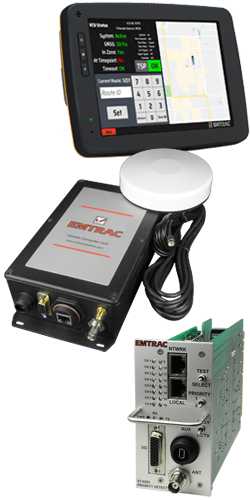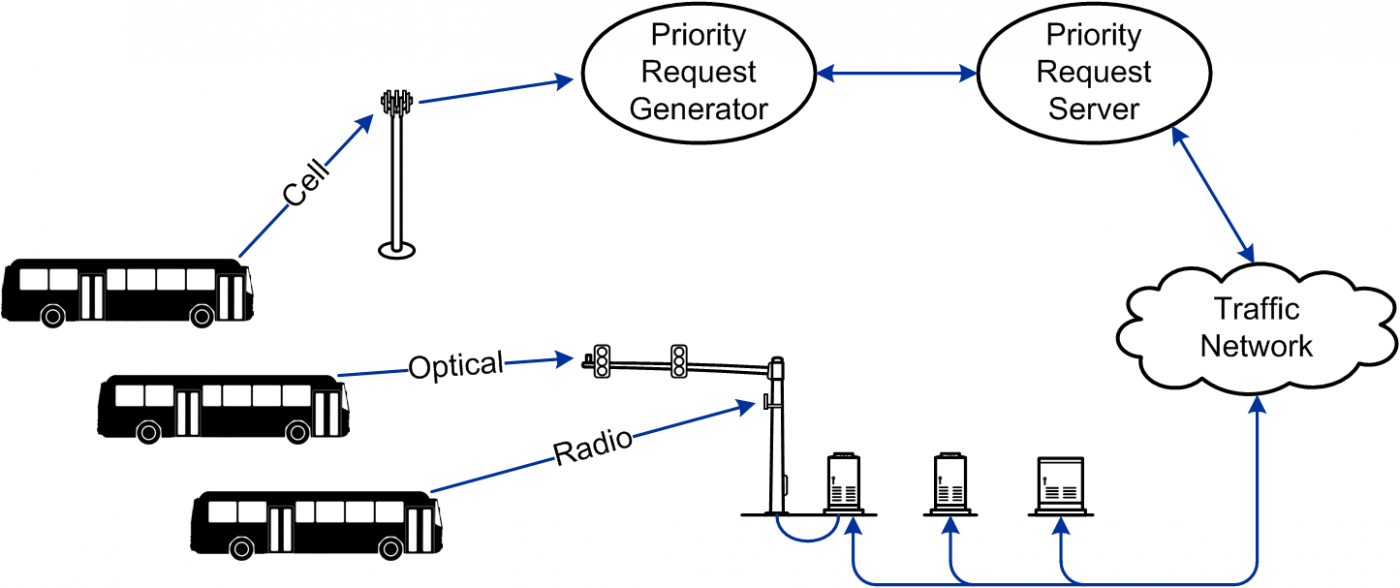
Transit Signal Priority systems are installed in cities throughout North America—in an extremely wide range of configurations. These configurations include optical, radio, cellular, Wi-Fi, and other wireless technologies. For many transit departments, a primary question is how can we upgrade and expand our current signal-priority system without having to replace all of our intersections that are already equipped?
The answer to this question depends on both the city’s current signal-priority configuration and the desired end configuration. For more detailed explanations of the various technologies available, refer to TSP Technologies sidebar below. Here are some examples:
For cities with optical signal priority, the answer is relatively easy—and it does not require replacing all of the optical components on equipped vehicles and intersections.
At the intersection, replacing the traffic-cabinet mounted phase selector with a dual RF/Optical Priority Detector enables receiving priority requests from both vehicles equipped with legacy optical systems, as well as vehicles equipped with the more reliable RF-based system. An omni-directional antenna is also installed to extend communications range for RF-equipped vehicles. Under typical urban RF-propagation conditions, the effective communication range is 3,500 feet (over 1,000 meters).
For vehicles installed with optical systems, no additional installation is necessary—although agencies can choose to add GPS/RF capability to enhance precision. For newer vehicles, or vehicles being equipped with signal priority for the first time, the RF-based system is installed. At this point, vehicles installed with either system can request signal priority.

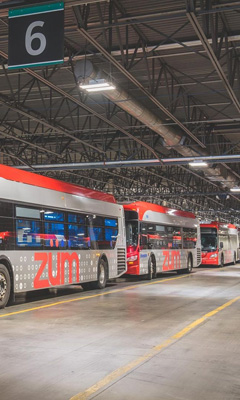
Agencies using an optical system have options for how to transition to a cloud-based architecture. The key objective is to provide vehicle data to the hosting data center where signal-priority decisions will be made.
The first option is to let the traffic-cabinet-mounted Priority Detectors provide vehicle data to the data center as they receive this data from vehicles en route. This option does not require installation of new equipment on vehicles already equipped with the optical system.
The second option is to replace the optical vehicle equipment with the EMTRAC vehicle computer, which then enables vehicles to wirelessly transmit vehicle information to the data center (via secure radio, cell, Wi-Fi, or other methods).
Most signal-priority systems are part of a distributed architecture, where the decision to grant priority is handled at the intersection. A common concern with distributed systems is that traffic controllers are not equipped to handle all the various data inputs that should influence whether signal priority is granted or denied. These inputs may include current traffic conditions, the vehicle’s estimated time of arrival at equipped intersections (ETA), current headway between transit vehicles, and so forth.

These factors are not a problem for the EMTRAC system because EMTRAC-equipped vehicles are intelligent. The EMTRAC vehicle computer knows the precise vehicle position, current traffic conditions, including intersection ETA, and many other data points. And EMTRAC Priority Detectors are network connected, so additional data may also be evaluated before signal priority is requested.
This intelligence and connectivity makes the switch from a distributed EMTRAC system to a centrally-controlled system perhaps the easiest transition of all. EMTRAC-equipped vehicles are capable of wireless communication via cellular, 900 MHz radio, and WiFi. Securely transmitting accurate data to the cloud is nothing new for EMTRAC.
To learn more about how the EMTRAC system can deliver the required capabilities for your upcoming TSP project, please visit our website or contact us.
TSP Technologies
Optical Signal Priority
For many years, optical communication was the only real option for agencies looking to implement signal priority in their cities. These systems include an “emitter” mounted in the vehicle, which flashes pulsed frequencies of light toward an optical sensor mounted at the intersection.
One drawback for optical systems is the need for direct line of sight, which limits the distance and approach path from which priority may be requested. Another drawback is the need to periodically clean the lenses on the mast-arm mounted optical sensors. Because cleaning lenses is so labor intensive, traffic departments typically put off cleaning them until other issues require a bucket truck on site. This inevitably results in diminished effectiveness of optical systems over time.

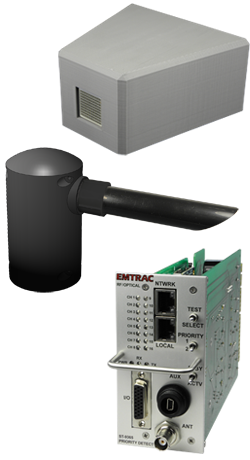
Wireless Signal Priority
The advent of radio-based communications greatly expanded the range and environments from which signal priority could be requested. For these systems, vehicles carry a transceiver, which sends AES-encrypted requests to a detector located in the traffic cabinet. This method does require an antenna mounted at the intersection. These antennas are typically pole mounted, but some traffic departments choose to go with a low-profile antenna mounted on the traffic cabinet itself (as shown). Wireless communications also opened up the ability to process and respond to transit conditions remotely.
Radio-based communications have opened the path for various other wireless methods, including cellular, WiFi, and others (each with their own strengths and weaknesses). Additionally many transit vehicles are already equipped with transit systems that include GPS positioning. And it’s not uncommon for a transit fleet to be made up of vehicles with differing signal-priority technologies.

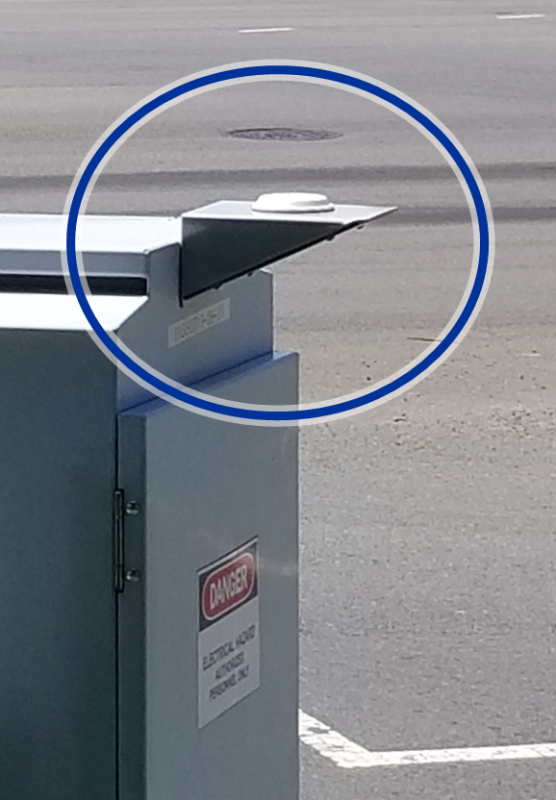
Cloud-Based Signal Priority
Transit agencies in some of the larger metro areas have chosen to move signal priority from a distributed system to a centrally-controlled system, where the decision point for whether signal priority should be requested takes place at a secure data center (that is, “the Cloud”). This is different from most optical and wireless systems, where signal priority is controlled at the vehicle and intersection level (that is, distributed).
One advantage of cloud-based systems, over non-EMTRAC distributed systems, is the ability to base signal-priority decisions on real-time vehicle and traffic conditions. Because these decisions are made at the data center, any number of conditions may be utilized to activate signal priority.
To implement cloud-based signal priority, all relevant vehicle and intersection data must be sent to the data center where the need for signal priority may be evaluated based on conditional factors. Vehicles must be equipped with a control computer to both process the need for signal priority and forward the request to the data center. This may be done with an EMTRAC vehicle computer, or by embedded software running on an existing bus computer. Positional accuracy and system security are two of the most important criteria for an effective cloud-based priority system.

